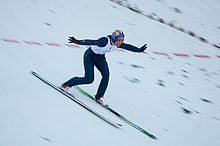Telemark landing
The telemark landing , or “ telemark ” for short by experts , is a landing technique in ski jumping that Torju Torjussen first tried out in 1883 and which has proven to be a safe landing technique to this day. One speaks of it when a ski jumper, when landing, pushes one ski a little further forward and the other ski a little further back. The ski binding does not count as the landing point, but the middle between the heel of the front foot and the toe of the rear foot. The upper body must be slightly straightened and catch the jump by kneeling down slightly.
Origin of name
The landing technique got its name from the skiing technique Telemarken , which originated in the Norwegian province of Telemark , from which Torjussen also came.
Evaluation of the landing
The jumper should
- from a stable, optimal flight position, straighten the head and upper body, move the arms sideways forwards / upwards and turn the skis into the parallel position;
- immediately before touching the ground with the ends of the ski, take a slight step and bend slightly in the knee joints;
- after the ski ends touch the ground, actively support the braking of the landing impulse through the elastic resistance forces of the sagging rear parts of the ski through the use of muscle power; at the same time
- Increase the step position further and bend your back leg correspondingly deeper ( telemark leg position ) and, with narrow ski guidance, distribute the landing pressure evenly on both sides and stretch your arms horizontally forwards / upwards to stabilize your balance.
Evaluation criteria
- Harmonious transition when opening the approach position for landing.
- Take a low step and bend position when you first touch the ground.
- Active participation in braking through the elastic resistance forces of the sagging skis.
- Stable mastering of the landing thrust through optimal bending (not too deep and not too long held) and increasing the step position.
- Full telemark leg position at the end of the braking phase, i.e. That is, middle step position (distance from the heel of the front shoe to the tip of the rear shoe approximately one shoe length, at least the tip of the rear shoe behind the heel of the front shoe) and significantly lower flexion of the rear leg.
- Narrow and neat ski guidance (distance between the skis no greater than two ski widths and parallel guidance and full surface).
Point deductions
- Maximum deduction for the entire movement segment 5.0 pts.
- No telemark leg position (parallel foot position) at the end of the landing process (as a single error) min. 2.0 pts.
Individual evidence
- ↑ International Ski Competition Rules (IWO) Ski Jumping Website of the International Ski Association. Retrieved January 29, 2020.
Web links
Commons : Telemark Landing - Collection of images, videos and audio files
Wiktionary: Telemark - explanations of meanings, word origins, synonyms, translations
